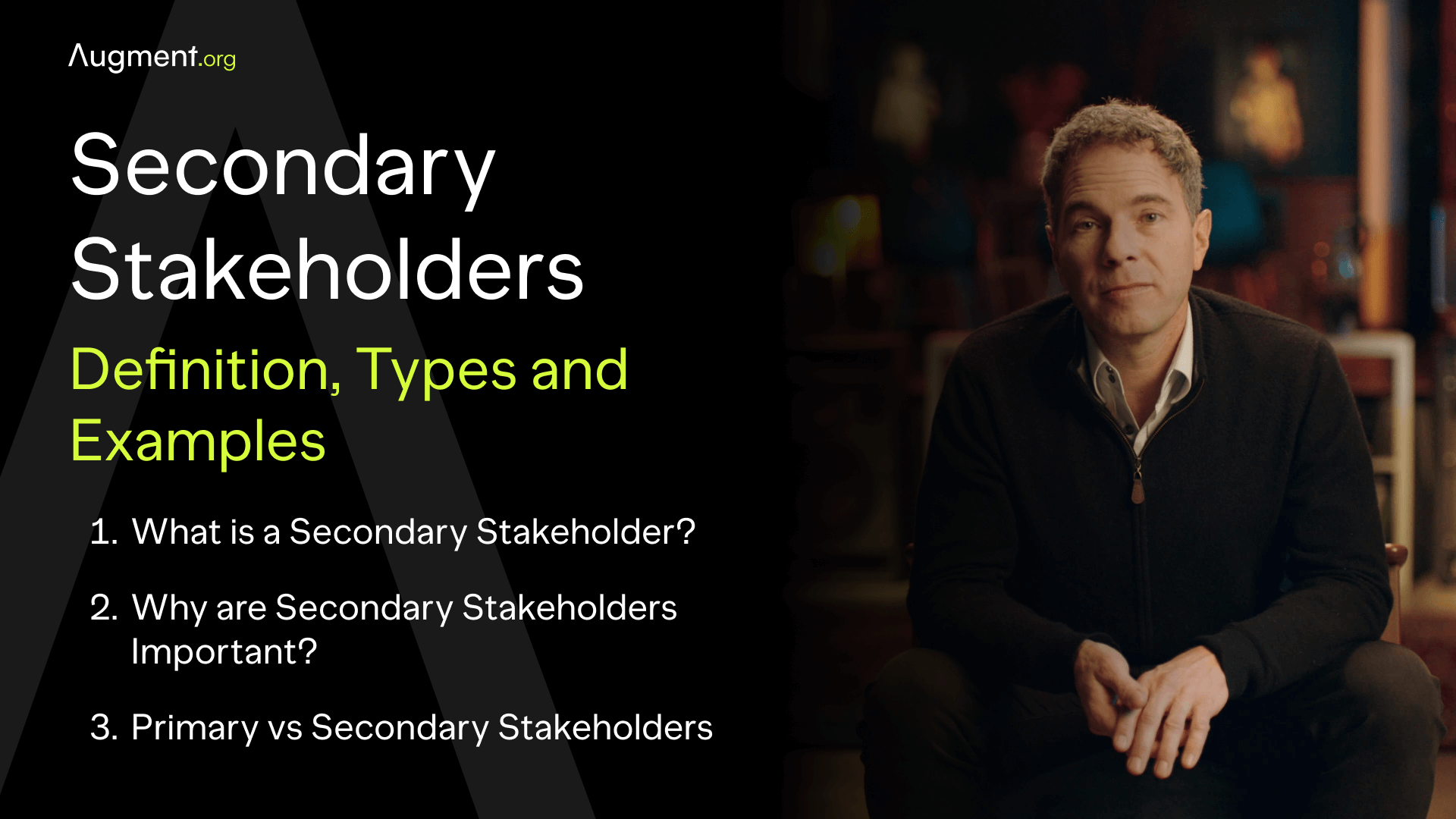Secondary Stakeholders: Definition, Types, and Examples
Secondary stakeholders are vital yet often overlooked components in the project management process, influencing a company's success from the sidelines.

What is a Secondary Stakeholder?
Secondary stakeholders are key players in the realm of project management and business operations, yet their role is often less direct compared to primary stakeholders. These stakeholders do not engage in day-to-day operations of a company but still hold a significant interest in its outcomes. Examples of secondary stakeholders include local communities, government agencies, trade unions, and special interest groups.
Their influence on a business is indirect but pivotal. For instance, while a retail company may not directly interact with a local community in its daily business, the community's well-being and perception can greatly affect the company's reputation and long-term success. Similarly, government agencies, though not involved in the daily management of a business, have a hand in shaping policies that can impact the organization's operations.
In essence, secondary stakeholders are those groups or individuals who, while not directly involved in a company's internal decisions, are still indirectly affected by its actions and success. Their input, feedback, and support play a vital role in shaping a business's public image, stakeholder relationships, and overall success. Understanding who these stakeholders are and how they influence a business is crucial for effective stakeholder engagement and management.
Why are Secondary Stakeholders Important?
Understanding the importance of secondary stakeholders is crucial in project management and strategic decision-making. These stakeholders, although not directly involved in a business's day-to-day operations, significantly influence its success and public perception. Their importance lies in their ability to affect, indirectly but powerfully, the organization's actions and long-term stability.
For example, while secondary stakeholders like trade unions or community groups may not make business decisions, their concerns and feedback can shape public opinion and influence a company's reputation. This indirect interest and influence can have a profound impact on a company's operational and strategic choices. Secondary stakeholders often provide valuable external perspectives, highlighting issues or opportunities that internal stakeholders might overlook.
Their role in stakeholder support and stakeholder feedback mechanisms is essential for businesses to navigate complex social, economic, and political landscapes. By considering the views and interests of various stakeholders, including both primary and secondary groups, organizations can make more balanced and responsible decisions, leading to sustainable business success.
Types of Secondary Stakeholders in a Business
In the landscape of project management and organizational strategy, identifying various types of secondary stakeholders is key. These stakeholders, while not directly involved in a company's operations, hold influence over its long-term success and public image.
- Local Communities: These groups are indirectly affected by a company's operations and decisions. For example, a manufacturing company's environmental policies can significantly impact the surrounding community's quality of life.
- Government Agencies: Though not having a direct financial stake, these bodies can influence business practices through regulation and legislation, affecting the company's operations and strategies.
- Activist Groups: They play a crucial role in raising awareness about issues that can affect a company's reputation and, consequently, its success. Their concerns often lead businesses to consider corporate social responsibility more seriously.
- Trade Unions: While not part of a company's internal stakeholder groups, they represent employee interests and can influence labor policies and practices.
- Media Outlets: The media can shape public perception and have a significant impact on an organization's reputation and stakeholder relationships.
- Suppliers and Business Partners: These groups, although primarily involved in transactional relationships, have vested interests in the company's stability and success.
Each type of secondary stakeholder brings unique concerns and perspectives, influencing a company's decision-making process and project outcomes. Their indirect but significant role in shaping a company's actions highlights the importance of inclusive stakeholder engagement for long-term business success.
Primary vs Secondary Stakeholders
In the world of business and project management, stakeholders are often categorized into two groups: primary and secondary. Understanding the differences between these groups is crucial for effective stakeholder engagement and project success.
- Primary Stakeholders: These are individuals or groups directly involved in the business and who have a direct financial interest. Examples of primary stakeholders include employees, customers, and suppliers. They are directly affected by the company's decisions and actions and have a vested interest in the company's success. For instance, employees rely on the company for their livelihood, while customers depend on the company to provide goods and services.
- Secondary Stakeholders: Unlike primary stakeholders, secondary stakeholders do not have a direct financial stake in the company. However, they can still influence or be affected by the company's actions. Examples of secondary stakeholders include local communities, government agencies, and activist groups. These stakeholders may not purchase goods or services from the company or be involved in its day-to-day operations, but their support and input can significantly affect the company's reputation and long-term success.
The key difference lies in the directness of their involvement and interest. Primary stakeholders have a direct engagement with the company and are directly affected by its actions, while secondary stakeholders have an indirect interest. Both play crucial roles, but their influence and concerns differ. Understanding these distinctions helps organizations identify stakeholder needs and address them appropriately, ensuring a balanced approach to stakeholder management and organizational success.



